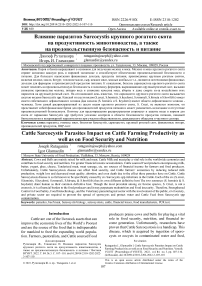Cattle Sarcocystis parasites impact on cattle farming productivity as well as on food security and nutrition
Автор: Rutaganira Joseph, Glamazdin I.
Журнал: Вестник Воронежского государственного университета инженерных технологий @vestnik-vsuet
Рубрика: Пищевая биотехнология
Статья в выпуске: 3 (93), 2022 года.
Бесплатный доступ
Cows and Bulls are mainly raised for milk and meat. Cattle Milk and meat play a vital role in the worldwide economies and contribute to food security and nutrition. For greater financial income accumulation, Cattle sourced Food products encompassing milk, butter, yogurt, ghee, cheese, Tenderized meat, meat sausage, etc. are sources of financial income for farmers and food producers. Unfortunately, Cattle Sarcocystosis disease can affect food security, and Cattle farmers’ economies by inducing reduced milk production, weight loss and decreased meat quality, abortion, and even death due to the effect these parasites have on Cattle (Hoeve-Bakker et al., 2019). Cattle Sarcocystosis disease is so far known to be specifically caused by six Sarcocystis spp infections in the Cattle. Each of the six (S.cruzi, S.hominis, S.heydorni, S.rommeli, S.hirsuta, & S.bovifelis) has its own different definitive host The two zoonoses (S. hominis & S. heydorni) share human as their common definitive host. Though the most prevalent among six bovine species, S. Cruzi, is not a zoonosis (Ayazian Mavi et al., 2020), it is a financial burden to the food producers and it may perpetuate malnutrition and Food insecurity. Therefore, Strengthened Control in Food Safety, Food biotechnology, and the Veterinary parasitological sector with the involvement of the public, civil society, and private sector are required to prevent the spread of sporocysts and protect water and Cattle Feed from Sarcocystis spp contamination.
Parasites, beef meat, sarcocystis biology, sarcocystosis, cattle, financial losses, food manufacturers, pcr test
Короткий адрес: https://sciup.org/140297621
IDR: 140297621 | DOI: 10.20914/2310-1202-2022-3-107-110
Список литературы Cattle Sarcocystis parasites impact on cattle farming productivity as well as on food security and nutrition
- Argent J., Augsburg B., Rasul I. Livestock asset transfers with and without training: Evidence from Rwanda. Journal of Economic Behavior & Organization. 2014. vol. 108. pp. 19-39. https://doi.org/10.1016/j.jebo.2014.07.008
- Mavi S.A., Teimouri A., Mohebali M., Yazdi M.K.S.et al. Sarcocystis infection in beef and industrial raw beef burgers from butcheries and retail stores: A molecular microscopic study. Heliyon. 2020. vol. 6. no. 6. pp. e04171. https://doi.org/10.1016/j.heliyon.2020.e04171
- Dorny P., Praet N., Deckers N., Gabriël S. Emerging food-borne parasites. Veterinary parasitology. 2009. vol. 163. no. 3. pp. 196-206. https://doi.org/10.1016/j.vetpar.2009.05.026
- Dorny P., Praet N., Deckers N., Gabriel S. Emerging food-borne parasites. Veterinary parasitology. 2009. vol. 163. no. 3. pp. 196-206. https://doi.org/10.1016/j.vetpar.2009.05.026
- Fayer R. Sarcocystis spp. in human infections. Clinical microbiology reviews. 2004. vol. 17. no. 4. pp. 894-902. https://doi.org/10.1128/CMR.17.4.894-902.2004
- Hoeve-Bakker B.J.A., van der Giessen J.W.B., Franssen F.F.J. Molecular identification targeting cox1 and 18S genes confirms the high prevalence of Sarcocystis spp. in cattle in the Netherlands. International journal for parasitology. 2019. vol. 49. no. 11. pp. 859-866. https://doi.org/10.1016/j.ijpara.2019.05.008
- Khalifa R.M., El-Nadi N.A., Sayed F.G., Omran E.K. Comparative morphological studies on three Sarcocystis species in Sohag, Egypt. Journal of the Egyptian Society of Parasitology. 2008. vol. 38. no. 2. pp. 599-608.
- Kojouri G.A., Aghajani E., Jahanabadi S., Kojouri A. Mineral status of myocardial Sarcocystosis. Iranian Journal of parasitology. 2011. vol. 6. no. 2. pp. 17.
- Marco M.L., Smid E.J. Editorial overview: Food biotechnology: Exploration and exploitation of microbial resources to address the need for sustainable production of safe, healthy and nutritious food. Current opinion in biotechnology. 2018. vol. 49. pp. v-vii. https://doi.org/10.1016/j.copbio.2017.11.011
- Moré G., Pantchev A., Skuballa J., Langenmayer M.C. et al. Sarcocystis sinensis is the most prevalent thick-walled Sarcocystis species in beef on sale for consumers in Germany. Parasitology Research. 2014. vol. 113. no. 6. pp. 2223-2230. https://doi.org/10.1007/s00436-014-3877x
- Ortega Y.R., Pape J.W. Cyclospora, Isospora, and Sarcocystis Infections //Tropical Infectious Diseases: Principles, Pathogens and Practice. WB Saunders, 2011. pp. 641-645. https://doi.org/10.1016/B978-0-7020-3935-5.00095-1
- Savini G., Robertson I.D., Dunsmore J.D. Sensitivities and specificities of two ELISA tests for detecting infection with Sarcocystis in cattle of Western Australia. Preventive Veterinary Medicine. 1997. vol. 32. no. 1-2. pp. 35-40 https://doi.org/10.1016/S0167-5877(97)00001-9
- Sub-Saharan Africa. URL: https://www.fao.org/faostat/en/#data/FS, 2020.
- Moré G., Pantchev A., Skuballa J., Langenmayer M.C. et al. Sarcocystis sinensis is the most prevalent thick-walled Sarcocystis species in beef on sale for consumers in Germany. Parasitology Research. 2014. vol. 113. no. 6. pp. 2223-2230. https://doi.org/10.1007/s00436-014-3877-x
- Rahdar M., Kardooni T. Molecular identification of Sarcocystis spp. in sheep and cattle by PCR-RFLP from southwest of Iran. Jundishapur Journal of Microbiology. 2017. vol. 10. no. 8. https://doi.org/10.5812/jjm.12798
- Mirzaei M., Rezaei H. A survey on Sarcocystis spp. infection in cattle of Tabriz city, Iran. Journal of Parasitic Diseases. 2016. vol. 40. no. 3. pp. 648-651. https://doi.org/10.1007/s12639-014-0551-2
- Hornok S., Mester A., Takács N., Baska F. et al. Sarcocystis-infection of cattle in Hungary. Parasites & vectors. 2015. vol. 8. no. 1. pp. 1-6. https://doi.org/10.1186/s13071-015-0685-9
- Amairia S., Amdouni Y., Rjeibi M.R., Rouatbi M. et al. First molecular detection and characterization of Sarcocystis species in slaughtered cattle in North-West Tunisia. Meat science. 2016. vol. 122. pp. 55-59. https://doi.org/10.1016/j.meatsci.2016.07.021
- Imre K., Dărăbuș G., Tîrziu E., Morariu S. et al. Sarcocystis spp. in romanian slaughtered cattle: molecular characterization and epidemiological significance of the findings. BioMed Research International. 2019.
- Dubey J.P., Fayer R., Rosenthal B.M., Calero-Bernal R. et al. Identity of Sarcocystis species of the water buffalo (Bubalus bubalis) and cattle (Bos taurus) and the suppression of Sarcocystis sinensis as a nomen nudum. Veterinary Parasitology. 2014. vol. 205. no. 1-2. pp. 1-6. https://doi.org/10.1016/j.vetpar.2014.06.02


